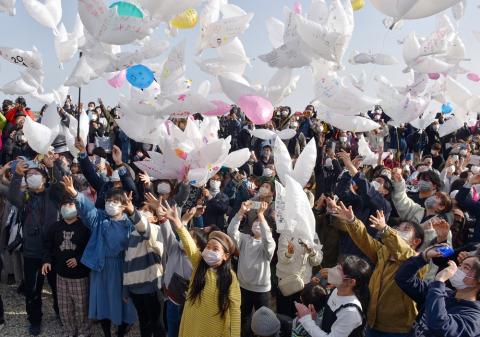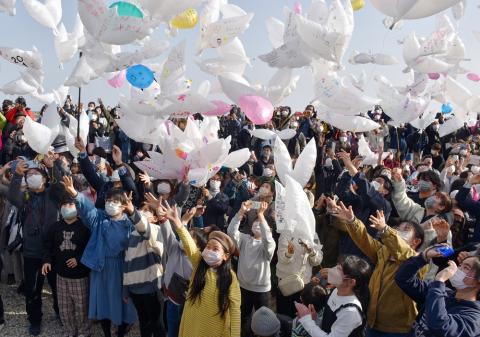
Japan has observed a moment’s silence to mark the 10th anniversary of an earthquake and tsunami that killed more than 18,000 people and triggered a nuclear meltdown in Fukushima.
At 2:46 pm, the moment Japan’s north-east coast was struck by a magnitude 9.0 earthquake on 11 March 2011, people attending private and public service across the affected region bowed and fell silent, some clasping their hands in prayer.
In Tokyo, the prime minister, Yoshihide Suga, and the emperor, Naruhito, offered their condolences at a socially distanced ceremony at the national theatre.
Naruhito said the “unforgettable memory of the tragedy” persisted a decade on, adding: “Many of those afflicted, in spite of their having suffered from unimaginably enormous damage, have overcome numerous hardships by helping one another.”
Suga said the challenges faced by survivors had been compounded by the pandemic and natural disasters, including a recent strong quake in the region, classified as an aftershock of the 2011 tremor. But he said Japan had always “overcome every crisis with courage and hope”.
Events to mark the anniversary of the March 2011 triple disaster have been scaled down due to the coronavirus epidemic, with many people choosing to hold small gatherings to remember friends, colleagues and family members who died.
In Iwaki, a city 50 km (31 miles) from the Fukushima Daiichi nuclear power plant, Atsushi Niizuma prayed for his mother, who was killed by the tsunami.
“I want to tell my mother that my children, who were all close to her, are doing well. I came here to thank her that our family is living safely,” said Niizuma, a restaurateur.
Much of the coastal towns and villages swept away by the tsunami have been rebuilt at an estimated cost of ¥30 trillion ($280bn).
Roads, train lines, housing – and miles of protective seawalls have mostly been completed, but large swathes of land remain empty, with many communities struggling to restore their populations to pre-disaster levels.
Ten years on, more than 40,000 people are unable to return home, most of them from areas near Fukushima Daiichi, where the triple meltdown forced the immediate evacuation of 160,000 people.
While the plant’s operator, Tokyo Electric Power [Tepco], stabilised the damaged reactors at the end of 2011, work has barely begun to locate and remove melted nuclear fuel – a complex decommissioning operation that is expected to take at least 40 years and cost of billions of dollars.
Tepco and the Japanese government must also decide what to do with a million tonnes of contaminated water being stored in more than 1,000 tanks on the site. Tepco says the tanks’ 1.37 million tonne storage capacity will be full by the autumn of 2022.
The most likely option – slowly releasing it into the Pacific Ocean – is opposed by neighbouring countries and local fishers, who say the move would ruin efforts to rebuild their industry and livelihoods.
The anniversary came just two weeks before Fukushima hosts the start of the torch relay for the Tokyo 2020 Olympics, billed by Games organisers as a showcase for recovery efforts there and in the prefectures of Miyagi and Iwate, where most of tsunami deaths occurred.
Nayuta Ganbe, a resident of the city of Sendai, usually marks the anniversary in private, but said he had decided to take part in an official event this year to help process his grief.
“This is the day when I lost my classmates. People died before my eyes. March 11 is a day that I hoped would never come again,” the 21-year-old said.
Reverend Akira Sato, who ministered at several churches in areas near the nuclear plant that are still off-limits, planned to visit one of the abandoned churches.
“Together with my wife, I will silently think back over the days of the disaster and offer a prayer,” he said.
In Ishinomaki, where the tsunami killed an estimated 3,300 people, officials and guests attended the unveiling of a cenotaph to the victims. “As a place that was hit hard by the disaster, we want to carry forward its memory so that such a sacrifice never needs to be made again,” the city’s mayor, Hiroshi Kameyama, said.












